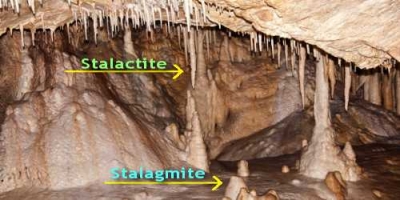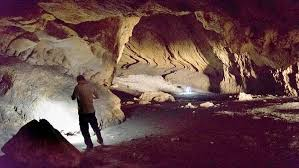
|
Over time stalactites, icicle-shaped structures, form and hang from the roof, while on the cave floor the mineral deposits accumulate to form tall cones, called stalagmites. |
Stalactite and stalagmite, elongated forms of various minerals deposited from solution by slowly dripping water. A stalactite hangs like an icicle from the ceiling or sides of a cavern. A stalagmite appears like an inverted stalactite, rising from the floor of a cavern.
Stalactites hanging from the ceilings of caverns commonly exhibit a central tube or the trace of a former tube whose diameter is that of a drop of water hanging by surface tension. A drop on the tip of a growing stalactite leaves a deposit only around its rim. Downward growth of the rim makes the tube. The simplest stalactite form, therefore, is a thin-walled stone straw, and these fragile forms may reach lengths of 0.5 m (20 inches) or more where air currents have not seriously disturbed the growth. The more common form is a downward-tapering cone and is simply a thickening of the straw type by mineral deposition from a film of water descending the exterior of the pendant.
Credit: Britannica
Picture Credit : Google




